| Cotingas | |
|---|---|

| |
| Spangled cotinga (Cotinga cayana) | |
| Scientific classification | |
| Domain: | Eukaryota |
| Kingdom: | Animalia |
| Phylum: | Chordata |
| Class: | Aves |
| Order: | Passeriformes |
| Parvorder: | Tyrannida |
| Family: | Cotingidae Bonaparte, 1849 |
| Genera | |
|
Many, see text | |

| |
| Geographical range of the cotingas. | |
The cotingas are a large family, Cotingidae, of suboscine passerine birds found in Central America and tropical South America. Cotingas are birds of forests or forest edges, that are primary frugivorous. They all have broad bills with hooked tips, rounded wings, and strong legs. They range in size from 12–13 cm (4.7–5.1 in) of the fiery-throated fruiteater (Pipreola chlorolepidota) up to 48–51 cm (19–20 in) of the Amazonian umbrellabird (Cephalopterus ornatus).
Description
Cotingas vary widely in social structure. There is a roughly 50/50 divide in the family between species with biparental care, and those in which the males play no part in raising the young. The purple-throated fruitcrow lives in mixed-sex groups in which one female lays an egg and the others help provide insects to the chick.
In cotinga species where only the females care for the eggs and young, the males have striking courtship displays, often grouped together in leks. Such sexual selection results in the males of these species, including the Guianan cock-of-the-rock, being brightly coloured, or decorated with plumes or wattles, like the umbrellabirds, with their umbrella-like crest and long throat wattles. Other lekking cotingids like the bellbirds and screaming piha, have distinctive and far-carrying calls. In such canopy-dwelling genera as Carpodectes, Cotinga, and Xipholena, males gather high in a single tree or in adjacent trees, but male cocks-of-the-rock, as befits their more terrestrial lives, give their elaborate displays in leks on the ground.
The females of both lekking and biparental species are duller than the males.
Breeding
Nests range from tiny to very large. Many species lay a single egg in a nest so flimsy that the egg can be seen from underneath. This may make the nests hard for predators to find. Fruiteaters build more solid cup nests, and the cocks-of-the-rock attach their mud nests to cliffs. The nests may be open cups or little platforms with loosely woven plant material, usually placed in a tree. The clutches comprise one to four eggs. Incubation typically takes 15–28 days. Fledging usually occurs at 28–33 days.
Habitat
Deserts, open woodlands, coastal mangroves, and humid tropical forests comprise their habitats. Cotingas face very serious threats from the loss of their habitats.
Taxonomy and systematics
The family Cotingidae was introduced by French naturalist Charles Lucien Bonaparte in 1849. According to the International Ornithological Committee, as of July 2021, the family contains 66 species divided into 24 genera.
A 2014 molecular phylogenetic study of the cotingas by Jacob Berv and Richard Prum found that the genera formed five monophyletic clades and they proposed that the family could be divided into five subfamilies. The following cladogram is based on a molecular phylogenetic study of the suboscines by Michael Harvey and collaborators published in 2020.
| Cotingidae |
| ||||||||||||||||||||||||||||||||||||||||||||||||||||||||||||||||||||||||||||||||||||||||||||||||||||||||||||||||||||||||||||||||||||||||||
The genus Tijuca was found to be embedded in Lipaugus, a position that was confirmed by a more detailed 2020 study.
| Image | Genus | Living species |
|---|---|---|
 |
Ampelioides Verreaux, 1867 |
|
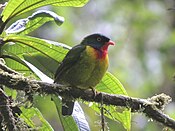 |
Pipreola Swainson, 1838 |
|
 |
Snowornis Prum, 2001 |
|
 |
Carpornis G.R. Gray, 1846 |
|
 |
Rupicola Brisson, 1760 |
|
 |
Phoenicircus Swainson, 1832 |
|
 |
Zaratornis Koepcke, 1954 |
|
 |
Phytotoma Molina, 1782 |
|
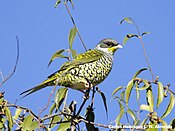 |
Phibalura Vieillot, 1816 |
|
 |
Doliornis Taczanowski, 1874 |
|
 |
Ampelion Tschudi, 1845 |
|
| Haematoderus Bonaparte, 1854 |
| |
 |
Querula Vieillot, 1816 |
|
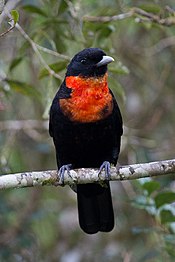 |
Pyroderus G.R. Gray, 1840 |
|
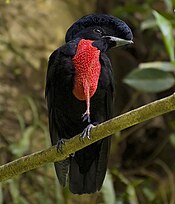 |
Cephalopterus E. Geoffroy Saint-Hilaire, 1809 |
|
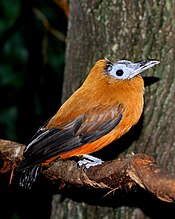 |
Perissocephalus Oberholser, 1899 |
|
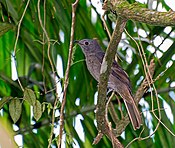 |
Lipaugus F. Boie, 1828 |
|
 |
Procnias Illiger, 1811 |
|
 |
Cotinga Brisson, 1760 |
|
 |
Porphyrolaema Bonaparte, 1854 |
|
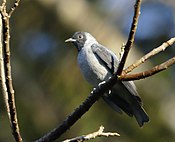 |
Conioptilon Lowery & O'Neill, 1966 |
|
 |
Gymnoderus E. Geoffroy Saint-Hilaire, 1809 |
|
 |
Xipholena Gloger, 1841 |
|
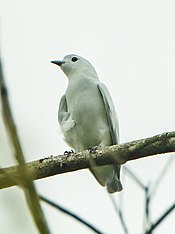 |
Carpodectes Salvin, 1865 |
|
A number of species previously placed in this family are now placed in the family Tityridae (genera Laniisoma, Laniocera and Iodopleura)
See also: List of cotinga speciesReferences
- Snow, D.; Sharpe, C.J. (2018). del Hoyo, J.; Elliott, A.; Sargatal, J.; Christie, D.A.; de Juana, E. (eds.). "Fiery-throated Fruiteater (Pipreola chlorolepidota)". Handbook of the Birds of the World Alive. Lynx Edicions. doi:10.2173/bow.fitfru1.01. S2CID 243289215. Retrieved 30 June 2018.
- Snow, D. (2018). del Hoyo, J.; Elliott, A.; Sargatal, J.; Christie, D.A.; de Juana, E. (eds.). "Amazonian Umbrellabird (Cephalopterus ornatus)". Handbook of the Birds of the World Alive. Lynx Edicions. doi:10.2173/bow.amaumb1.01. S2CID 216264434. Retrieved 30 June 2018.
- Cockburn, Andrew (2006). "Prevalence of different modes of parental care in birds". Proceedings of the Royal Society B: Biological Sciences. 273 (1592): 1375–1383. doi:10.1098/rspb.2005.3458. PMC 1560291. PMID 16777726. Supplementary Material.
- ^ Prum, Richard O.; Snow, David W. (2003). "Cotingas". In Christopher Perrins (ed.). Firefly Encyclopedia of Birds. Firefly Books. pp. 432–433. ISBN 1-55297-777-3.
- Complete Birds of the World. National Geographic. p. 200.
- Bock, Walter J. (1994). History and Nomenclature of Avian Family-Group Names. Bulletin of the American Museum of Natural History. Vol. 222. New York: American Museum of Natural History. p. 149. hdl:2246/830.
- Gill, Frank; Donsker, David; Rasmussen, Pamela, eds. (July 2021). "Cotingas, manakins, tityras, becards". IOC World Bird List Version 11.2. International Ornithologists' Union. Retrieved 7 December 2021.
- Berv, J.S.; Prum, R.O. (2014). "A comprehensive multilocus phylogeny of the Neotropical cotingas (Cotingidae, Aves) with a comparative evolutionary analysis of breeding system and plumage dimorphism and a revised phylogenetic classification". Molecular Phylogenetics and Evolution. 81: 120–136. doi:10.1016/j.ympev.2014.09.001. PMID 25234241.
- Harvey, M.G.; Bravo, G.A.; Claramunt, S.; Cuervo, A.M.; Derryberry, G.E.; Battilana, J.; Seeholzer, G.F.; McKay, J.S.; O’Meara, B.C.; Faircloth, B.C.; Edwards, S.V.; Pérez-Emán, J.; Moyle, R.G.; Sheldon, F.H.; Aleixo, A.; Smith, B.T.; Chesser, R.T.; Silveira, L.F.; Cracraft, J.; Brumfield, R.T.; Derryberry, E.P. (2020). "The evolution of a tropical biodiversity hotspot". Science. 370 (6522): 1343–1348. Bibcode:2020Sci...370.1343H. doi:10.1126/science.aaz6970. hdl:10138/329703. PMID 33303617. S2CID 228084618. A high resolution version of the phylogenetic tree in Figure 1 is available from the first author's website here.
- Settlecowski, A.E.; Cuervo, A.M.; Tello, J.G.; Harvey, M.G.; Brumfield, R.T.; Derryberry, E.P. (2020). "Investigating the utility of traditional and genomic multilocus datasets to resolve relationships in Lipaugus and Tijuca (Cotingidae)". Molecular Phylogenetics and Evolution. 147: 106779. doi:10.1016/j.ympev.2020.106779. PMID 32135309. S2CID 212568712.
- Remsen, J. V. Jr., C. D. Cadena, A. Jaramillo, M. Nores, J. F. Pacheco, M. B. Robbins, T. S. Schulenberg, F. G. Stiles, D. F. Stotz, & K. J. Zimmer. 2007. A classification of the bird species of South America. Archived March 2, 2009, at the Wayback Machine American Ornithologists' Union. Accessed 12 December 2007.
Further reading
- Snow, D.W. (1976). "The relationship between climate and annual cycles in the Cotingidae." Ibis 118(3):366-401
- Snow, D.W. (1982). The Cotingas: Bellbirds, Umbrella birds and their allies. British Museum Press. ISBN 0-19-858511-X
External links
- Cotinga videos on the Internet Bird Collection
| Taxon identifiers | |
|---|---|
| Cotingidae | |
